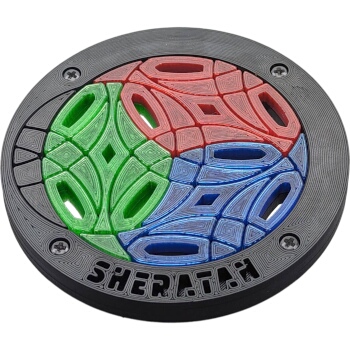|
Two intersecting circles. The smaller one turning in steps of 180�, the larger turning in steps of 120�. The circles intersect extremely deeply.
Beta Arietis (β Arietis, abbreviated Beta Ari, β Ari), officially named Sheratan/ˈʃɛrətæn/, is a star system and the second-brightest star in the constellation of Aries, marking the ram's second horn. The traditional name, Sheratan (or Sharatan, Sheratim), in full Al Sharatan, is from the Arabic الشرطان aš-šaraţān "the two signs", a reference to the star having marked the northern vernal equinox together with Gamma Arietis several thousand years ago. Sheratan has an apparent visual magnitude of 2.66. Based on parallax measurements, it is located at a distance of 59.6 light-years (18.3 parsecs) from Earth. This is a spectroscopic binary star system consisting of a pair of stars orbiting around each other with a separation that can not currently be resolved with a conventional telescope. However, the pair have been resolved using the Mark III Stellar Interferometer at the Mount Wilson Observatory. This allows the orbital elements to be computed, as well as the individual masses of the two stars. The stars complete their highly elliptical orbit every 107 days. The primary star has a stellar classification of A5 V, which means it is an A-type main-sequence star that is generating energy through the thermonuclear fusion of hydrogen in its core region. In a few million years, as the primary evolves toward a red giant, significant amounts of mass transfer to the secondary component is expected. The primary has been classified as a rapid rotator, with a projected rotational velocity of 73 km/s providing a lower bound on the azimuthal rotational velocity along the equator. It may also be a mildly Am star, which is a class of stars that show a peculiar spectrum with strong absorption lines from various elements and deficiencies in others. In β Arietis, these absorption lines are broadened because of the Doppler effect from the rotation, making analysis of the abundance patterns difficult. Diameter: 104 mm Contributors
No one has contributed to this page yet! Collections No one has added this puzzle to a collection yet! Found a mistake or something missing? Edit it yourself or contact the moderator. |
|






